Breage, Cornwall (†Truro) C.15
Warning to Sabbath Breakers
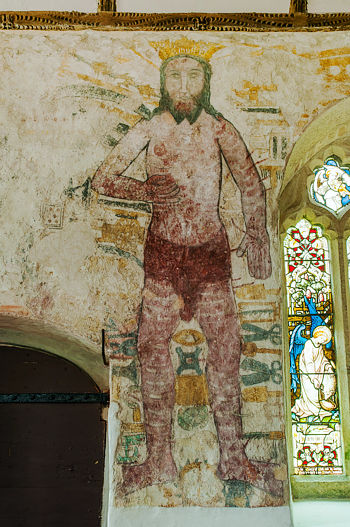
This painting has, like some other examples of the subject, been misidentified as Christ blessing agricultural and other implements; in fact it is perhaps the clearest and most unequivocal version of the Warning to Sabbath Breakers in England. Perhaps this is the moment to say clearly that I do not believe that paintings of Christ blessing implements and the human activities they imply were ever made in England. I suspect that this sentimental notion came about sometime in the late 19th or early 20th century, and that it is connected with beliefs about the dignity of labour and the innate sanctity of honest toil, especially of the kind carried out by the peasantry and other persons outside the ruling classes. Conclusions about what paintings like the Breage example were intended to convey were thus jumped to, I think, and the misidentification began.
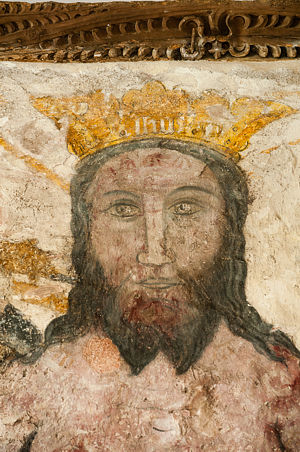
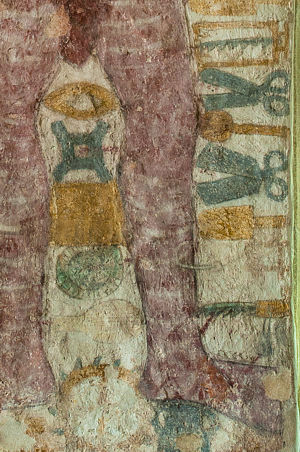
To begin with, there is no gesture of blessing here (in medieval painting, the act of blessing, by Christ himself or by priests, is seldom ambiguous). The Christ at Breage is indicating his wounded side, the site of his death-blow. He wears a crown, a detail unique among existing paintings of the subject (photo, right). The point thus emphasised, I think, is that despite his almost grotesquely blood-boltered appearance, he is nevertheless King of kings, and those who continue to ‘crucifie him daily’ by working on the Sabbath should be aware of the magnitude of their sin.
A very various collection of implements surrounds Christ’s figure, and although not all are identifiable now, there is a preponderance of edged tools intended for various types of cutting – scythe blades, axes, scissors and shears, at least one sickle, and particularly menacing saw-edged implements with savage teeth. An object between Christ’s feet is particularly interesting. Despite its resemblance to St Catherine’s spiked wheel (as at Hardley Street in Norfolk), it is more likely to be a water-wheel, but another resemblance, to the now-fallen Crown of Thorns, might be intentional. There are other objects of interest – just below Christ’s bent right elbow is a neatly-painted farm cart, and to the left of it is a playing card, as at Hesset. In the case of Breage, this looks like the five of diamonds, in which case the number, corresponding to the Five Wounds, was almost certainly deliberately chosen.
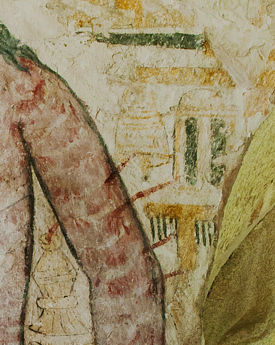
Other details here are more puzzling (detail, left). Between Christ’s left upper arm and the window splay, a spiked implement, perhaps for combing wool or something similar, is clear enough at the lower right. Above this though is what looks like a domed container of some kind, or perhaps even a small domed building. Clearer, to the left of this, is a pot-bellied ewer or jug (the handle, very faint, is just detectable on the left) and another jar or similar container is below, in the crook of the elbow. As with other examples of this subject, not all the surrounding implements are associated with actual labour – the pursuit of pleasure on Sundays is deplored as well, as at Hesset and Ampney St Mary.
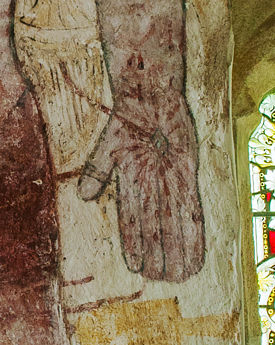
This implication is strengthened further, I think, by the most interesting object of all, one which can only be a harp, tucked into the space between Christ’s left wrist and his side. Matters are complicated by the many red lines in the painting ostensibly linking the implements themselves to Christ’s wounds, perhaps most explicitly so in the case of the harp and the very clear nail-hole on the left hand. The painting has been restored more than once, however, and I am uncertain about these lines, which might have been introduced by restoration to emphasise that precise cause-and-effect point. Restoration might also account for the mysterious ring-like object on Christ’s left thumb. The possibility that the original painter included a plectrum for playing the harp has to be considered, but the placing of it on Christ’s own hand is obviously incongruous, and I suspect that this plectrum, if that is what it is, is another misleading detail introduced by restoration.¹
In short, there are many puzzles at Breage, and the painting is certainly not as the medieval painter left it. But the most important objects in it – the playing card, the cart, the harp, the ewers for wine or other strong drink and above all Christ’s crown are I think undoubtedly original, making Breage an important reference point for the Warning to Sabbath-Breakers.
Not far from Breage, at St Just-in-Penwith and Poundstock are two other Warnings to Sabbath Breakers and the similarities and differences between the three are instructive. There are also many other paintings at Breage, including a heavily restored St Christopher and several local Cornish saints including Coryantin or Corentin, a Celtic hermit also venerated across the English Channel in Brittany.
Jump to the Breage St Christopher.
You can see a 360° panorama of the interior of the church here.
¹ There is some evidence that the wire-strung Cornish harp may have been played using a plectrum. A web page on The Wire-Strung Harp has useful further information.
† in page heading = Diocese
Photos © Roy Reed 2019